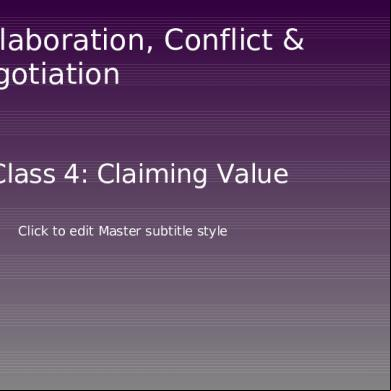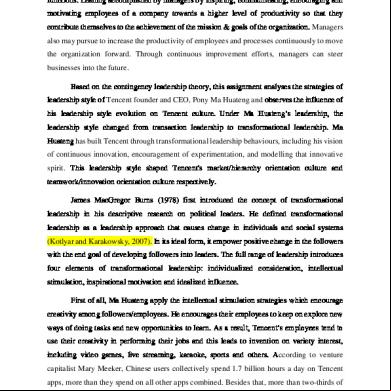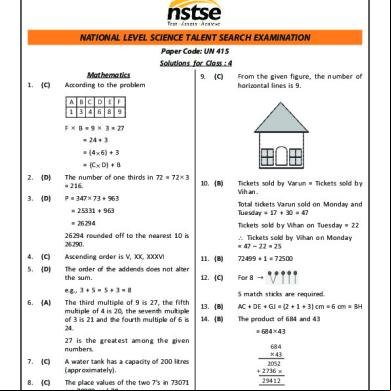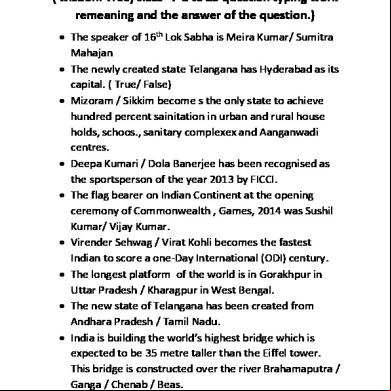Class 4 - Leading 1h323g
This document was ed by and they confirmed that they have the permission to share it. If you are author or own the copyright of this book, please report to us by using this report form. Report 3i3n4
Overview 26281t
& View Class 4 - Leading as PDF for free.
More details 6y5l6z
- Words: 1,239
- Pages: 37
Class 4: Leading
Who would you follow? What kind of person would you follow as a leader? Traits a leader should have
Leader vs. Manager Manager – An appointed position someone who is responsible for directing and controlling the work and employees of an organization Has authority to instruct, ensure compliance, reward and punish Plans, organizes, leads and controls
Leader Someone whom people willingly follow
5 Qualities of Good Leaders 1. Vision 1. Clear idea of where they are going and what trying to accomplish
2. Courage 1. Willingness to do the right thing even when it is difficult 2. “The foremost of the virtues, for upon it, all others depend” – Winston Churchill
3. Integrity 1. Truthfulness 2. Always tell the truth
5 Qualities of Good Leaders 4. Humility 1. Having the self-confidence to recognize the value of others with out feeling threatened 2. Willing to it you may be wrong or not have all the answers
5. Focus 1. Not get distracted https://www.briantracy.com/blog/leadership-success/theseven-leadership-qualities-of-great-leaders-strategilanning/
6 Leadership Qualities – Warren Bennis 1. Integrity 2. Dedication 3. Magnanimity
4. Humility 5. Openness 6. Creativity
6 Leadership Qualities – Tony Robinson 1. Confidence 2. Focus 3. Honesty
4. Positivity 5. Decisiveness 6. Inspirational
The Four Dimensions of Leadership – James Scouller 4 Dimensions – What leaders do 3 Levels – The context in which leaders lead.
Leadership Dimensions "Leadership is a process that involves (four dimensions):
1. setting a purpose and direction which inspires people to work towards willingly;
2. paying attention to the means, pace and quality of progress towards the aim;
3. upholding group unity, and 4. attending to individual effectiveness throughout.” (From The Three Levels of Leadership, James Scouller, 2011)
Four Dimensions of Leadership Dimension 1 – Motivating Purpose - Set purpose
that inspire others Dimension 2 – Task, progress, and Results –
Accomplish tasks and monitor progress Dimension 3 – Creating and Upholding Group Unity –
Team Spirit Dimension 4 – Attention to Individuals
Note The overall leader of a group does not have to lead in all 4 dimensions, others can lead in some of the dimensions
However, the overall leader has to ensure that leadership is happening in all 4 dimensions
Leader The person with overall responsibility for the group The leader has to ensure that all 4 dimensions of leadership are occuring
Leadership "The responsibility of a leader is to make sure there is leadership - to ensure that all four dimensions of leadership are being addressed... This means the leader does not always have to lead from the front; he or she can delegate, or share part of their responsibility for leadership. However, the buck still stops with the leader. So although the leader can let someone else lead in a particular situation, he or she cannot let go of responsibility to make sure there is (overall) leadership."
Leadership ultimate responsibility for leadership is retained by the leader.
Dimension 1 – Motivating Purpose Share a purpose that employees can get excited about People must care about the purpose Purpose must feel innately worthwhile
Purpose must benefit others Want people to be internally motivated
Motivation A drive A desire Persistence
Motivation Intrinsic motivation: inspires from within
Feel a part of something bigger than themselves Feeling of connection to others Working on a worthwhile challenge A chance to express your creativity
Extrinsic motivation – external to the person Punishment Reward
Dimension 2 – Task, Progress & Results Ensure the task is being accomplished Monitor progress and results Prioritize
Allow creativity
Dimension 3 – Creating & Upholding Group Unity Putting the group’s interest ahead of their own and ing each other
Team spirit
Most managers do not understand the importance of group unity
Together cam accomplish more than each individually
Potential Group Problems “Groupthink”
Preserve harmony Reduce conflict Avoid critical analysis Go along with bad plans
“Social loafing” Some don’t pull their weight
Hidden agendas Scapegoating
Cliques Conflict
Solution Create unity by Defining clear motivating purpose ing each other Sharing knowledge
Preserve unity by Ensuring everyone feel included and noticed understand how decisions made Building trust as people do what they commit to do
Results of disunity Sabotage Lack of coordination Lack of effort
Lack of communication Low output Lack of trust
Dimension 4 – Attention to Individuals Choose good people Notice each individual Understand their differences
Develop a personal relationship Be visible Wander around and chat with employees
Leadership – 3 levels 1. Public Leadership: leadership actions in a group setting. It covers dimensions 1, 2 and 3 (Direction/Purpose, Task, Group Unity).
2. Private Leadership: another outer or behavioural level. It covers dimensions 1, 2 and 4 (individual aspects of Direction, Task, attention to Individuals).
3. Personal Leadership: an inner level. It covers all four dimensions (Purpose, Task, Group Unity, Individuals), although less directly than the two outer levels.
1. Public Leadership Behaviours – Actions in a group setting (meeting) or influencing the org. as a whole to accomplish dimensions 1,2, and 3
1. Set direction Setting the vision Ensuring unity of purpose
1. Public Leadership Behaviours 2. Monitor the Task Achieving the group task Monitoring progress Creating peer pressure towards shared, high performance standards
1. Public Leadership Behaviours 3. Group Unity Create and uphold group identity and atmosphere of shared responsibility for overall performance Trust, togetherness Respect Sharing of information
1. Public Leadership Behaviours Some leaders overemphasize the first two and ignore the need to create team spirit
Others pay too much attention to atmosphere and insufficient to results
2. Private Leadership Behavours – handling of individual group Concerned with dimensions 1, 2 and 4, accomplishing individual tasks and developing individual relationships Getting to know each individual, what motivates him or her Agreeing on individual goals to the group goal Reviewing individual task performance Helping individuals grow beyond their current roles Disciplining and removing underperforming individuals
3. Personal Leadership – A leader’s personal growth
1. Technical Knowhow and Skill- Knowing the business you are in and understanding the people you lead (Individual psychology, group psychology, and time management)
2. Positive Attitude Towards Others – Believing others are as important as you and you are here to serve those you lead. Maintaining the relationship.
3. Self-Mastery – The power to control one’s actions, impulses, or emotions. Starts with self awareness.
Leadership Continuum Tells Sells Suggests
Consults s Delegates Abdicates
Ethics
Engineering Ethics Core Concepts Public interest Qualities of truth, honesty, and fairness Professional performance
Ethical Problems in Consulting and Construction Political contributions Distribution of public services Construction safety
Construction-Hyatt Regency
Ethical Problems Environmental Conflict of interest Gifts Inside Information
HW Give examples where the general manager of Calm Seas applies James Scouler’s theory of leadership, that is, where she applied the four dimensions and operated at the three levels.
Who would you follow? What kind of person would you follow as a leader? Traits a leader should have
Leader vs. Manager Manager – An appointed position someone who is responsible for directing and controlling the work and employees of an organization Has authority to instruct, ensure compliance, reward and punish Plans, organizes, leads and controls
Leader Someone whom people willingly follow
5 Qualities of Good Leaders 1. Vision 1. Clear idea of where they are going and what trying to accomplish
2. Courage 1. Willingness to do the right thing even when it is difficult 2. “The foremost of the virtues, for upon it, all others depend” – Winston Churchill
3. Integrity 1. Truthfulness 2. Always tell the truth
5 Qualities of Good Leaders 4. Humility 1. Having the self-confidence to recognize the value of others with out feeling threatened 2. Willing to it you may be wrong or not have all the answers
5. Focus 1. Not get distracted https://www.briantracy.com/blog/leadership-success/theseven-leadership-qualities-of-great-leaders-strategilanning/
6 Leadership Qualities – Warren Bennis 1. Integrity 2. Dedication 3. Magnanimity
4. Humility 5. Openness 6. Creativity
6 Leadership Qualities – Tony Robinson 1. Confidence 2. Focus 3. Honesty
4. Positivity 5. Decisiveness 6. Inspirational
The Four Dimensions of Leadership – James Scouller 4 Dimensions – What leaders do 3 Levels – The context in which leaders lead.
Leadership Dimensions "Leadership is a process that involves (four dimensions):
1. setting a purpose and direction which inspires people to work towards willingly;
2. paying attention to the means, pace and quality of progress towards the aim;
3. upholding group unity, and 4. attending to individual effectiveness throughout.” (From The Three Levels of Leadership, James Scouller, 2011)
Four Dimensions of Leadership Dimension 1 – Motivating Purpose - Set purpose
that inspire others Dimension 2 – Task, progress, and Results –
Accomplish tasks and monitor progress Dimension 3 – Creating and Upholding Group Unity –
Team Spirit Dimension 4 – Attention to Individuals
Note The overall leader of a group does not have to lead in all 4 dimensions, others can lead in some of the dimensions
However, the overall leader has to ensure that leadership is happening in all 4 dimensions
Leader The person with overall responsibility for the group The leader has to ensure that all 4 dimensions of leadership are occuring
Leadership "The responsibility of a leader is to make sure there is leadership - to ensure that all four dimensions of leadership are being addressed... This means the leader does not always have to lead from the front; he or she can delegate, or share part of their responsibility for leadership. However, the buck still stops with the leader. So although the leader can let someone else lead in a particular situation, he or she cannot let go of responsibility to make sure there is (overall) leadership."
Leadership ultimate responsibility for leadership is retained by the leader.
Dimension 1 – Motivating Purpose Share a purpose that employees can get excited about People must care about the purpose Purpose must feel innately worthwhile
Purpose must benefit others Want people to be internally motivated
Motivation A drive A desire Persistence
Motivation Intrinsic motivation: inspires from within
Feel a part of something bigger than themselves Feeling of connection to others Working on a worthwhile challenge A chance to express your creativity
Extrinsic motivation – external to the person Punishment Reward
Dimension 2 – Task, Progress & Results Ensure the task is being accomplished Monitor progress and results Prioritize
Allow creativity
Dimension 3 – Creating & Upholding Group Unity Putting the group’s interest ahead of their own and ing each other
Team spirit
Most managers do not understand the importance of group unity
Together cam accomplish more than each individually
Potential Group Problems “Groupthink”
Preserve harmony Reduce conflict Avoid critical analysis Go along with bad plans
“Social loafing” Some don’t pull their weight
Hidden agendas Scapegoating
Cliques Conflict
Solution Create unity by Defining clear motivating purpose ing each other Sharing knowledge
Preserve unity by Ensuring everyone feel included and noticed understand how decisions made Building trust as people do what they commit to do
Results of disunity Sabotage Lack of coordination Lack of effort
Lack of communication Low output Lack of trust
Dimension 4 – Attention to Individuals Choose good people Notice each individual Understand their differences
Develop a personal relationship Be visible Wander around and chat with employees
Leadership – 3 levels 1. Public Leadership: leadership actions in a group setting. It covers dimensions 1, 2 and 3 (Direction/Purpose, Task, Group Unity).
2. Private Leadership: another outer or behavioural level. It covers dimensions 1, 2 and 4 (individual aspects of Direction, Task, attention to Individuals).
3. Personal Leadership: an inner level. It covers all four dimensions (Purpose, Task, Group Unity, Individuals), although less directly than the two outer levels.
1. Public Leadership Behaviours – Actions in a group setting (meeting) or influencing the org. as a whole to accomplish dimensions 1,2, and 3
1. Set direction Setting the vision Ensuring unity of purpose
1. Public Leadership Behaviours 2. Monitor the Task Achieving the group task Monitoring progress Creating peer pressure towards shared, high performance standards
1. Public Leadership Behaviours 3. Group Unity Create and uphold group identity and atmosphere of shared responsibility for overall performance Trust, togetherness Respect Sharing of information
1. Public Leadership Behaviours Some leaders overemphasize the first two and ignore the need to create team spirit
Others pay too much attention to atmosphere and insufficient to results
2. Private Leadership Behavours – handling of individual group Concerned with dimensions 1, 2 and 4, accomplishing individual tasks and developing individual relationships Getting to know each individual, what motivates him or her Agreeing on individual goals to the group goal Reviewing individual task performance Helping individuals grow beyond their current roles Disciplining and removing underperforming individuals
3. Personal Leadership – A leader’s personal growth
1. Technical Knowhow and Skill- Knowing the business you are in and understanding the people you lead (Individual psychology, group psychology, and time management)
2. Positive Attitude Towards Others – Believing others are as important as you and you are here to serve those you lead. Maintaining the relationship.
3. Self-Mastery – The power to control one’s actions, impulses, or emotions. Starts with self awareness.
Leadership Continuum Tells Sells Suggests
Consults s Delegates Abdicates
Ethics
Engineering Ethics Core Concepts Public interest Qualities of truth, honesty, and fairness Professional performance
Ethical Problems in Consulting and Construction Political contributions Distribution of public services Construction safety
Construction-Hyatt Regency
Ethical Problems Environmental Conflict of interest Gifts Inside Information
HW Give examples where the general manager of Calm Seas applies James Scouler’s theory of leadership, that is, where she applied the four dimensions and operated at the three levels.





